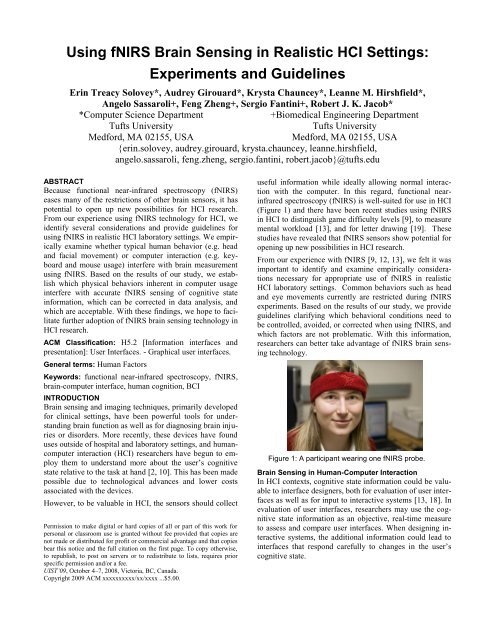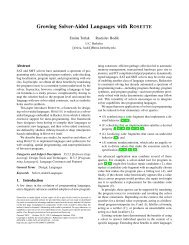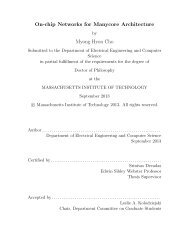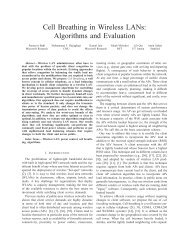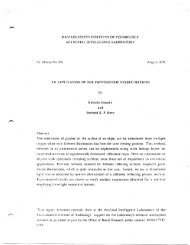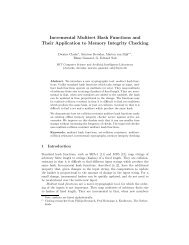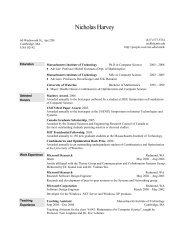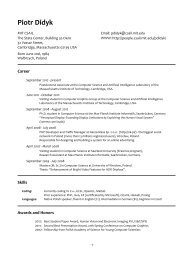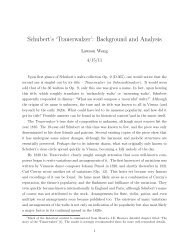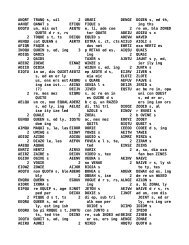Using fNIRS Brain Sensing in Realistic HCI Settings ... - CSAIL People
Using fNIRS Brain Sensing in Realistic HCI Settings ... - CSAIL People
Using fNIRS Brain Sensing in Realistic HCI Settings ... - CSAIL People
Create successful ePaper yourself
Turn your PDF publications into a flip-book with our unique Google optimized e-Paper software.
<strong>Us<strong>in</strong>g</strong> <strong>fNIRS</strong> <strong>Bra<strong>in</strong></strong> <strong>Sens<strong>in</strong>g</strong> <strong>in</strong> <strong>Realistic</strong> <strong>HCI</strong> Sett<strong>in</strong>gs:<br />
Experiments and Guidel<strong>in</strong>es<br />
Er<strong>in</strong> Treacy Solovey*, Audrey Girouard*, Krysta Chauncey*, Leanne M. Hirshfield*,<br />
Angelo Sassaroli+, Feng Zheng+, Sergio Fant<strong>in</strong>i+, Robert J. K. Jacob*<br />
*Computer Science Department<br />
+Biomedical Eng<strong>in</strong>eer<strong>in</strong>g Department<br />
Tufts University<br />
Tufts University<br />
Medford, MA 02155, USA<br />
Medford, MA 02155, USA<br />
{er<strong>in</strong>.solovey, audrey.girouard, krysta.chauncey, leanne.hirshfield,<br />
angelo.sassaroli, feng.zheng, sergio.fant<strong>in</strong>i, robert.jacob}@tufts.edu<br />
ABSTRACT<br />
Because functional near-<strong>in</strong>frared spectroscopy (<strong>fNIRS</strong>)<br />
eases many of the restrictions of other bra<strong>in</strong> sensors, it has<br />
potential to open up new possibilities for <strong>HCI</strong> research.<br />
From our experience us<strong>in</strong>g <strong>fNIRS</strong> technology for <strong>HCI</strong>, we<br />
identify several considerations and provide guidel<strong>in</strong>es for<br />
us<strong>in</strong>g <strong>fNIRS</strong> <strong>in</strong> realistic <strong>HCI</strong> laboratory sett<strong>in</strong>gs. We empirically<br />
exam<strong>in</strong>e whether typical human behavior (e.g. head<br />
and facial movement) or computer <strong>in</strong>teraction (e.g. keyboard<br />
and mouse usage) <strong>in</strong>terfere with bra<strong>in</strong> measurement<br />
us<strong>in</strong>g <strong>fNIRS</strong>. Based on the results of our study, we establish<br />
which physical behaviors <strong>in</strong>herent <strong>in</strong> computer usage<br />
<strong>in</strong>terfere with accurate <strong>fNIRS</strong> sens<strong>in</strong>g of cognitive state<br />
<strong>in</strong>formation, which can be corrected <strong>in</strong> data analysis, and<br />
which are acceptable. With these f<strong>in</strong>d<strong>in</strong>gs, we hope to facilitate<br />
further adoption of <strong>fNIRS</strong> bra<strong>in</strong> sens<strong>in</strong>g technology <strong>in</strong><br />
<strong>HCI</strong> research.<br />
ACM Classification: H5.2 [Information <strong>in</strong>terfaces and<br />
presentation]: User Interfaces. - Graphical user <strong>in</strong>terfaces.<br />
General terms: Human Factors<br />
Keywords: functional near-<strong>in</strong>frared spectroscopy, <strong>fNIRS</strong>,<br />
bra<strong>in</strong>-computer <strong>in</strong>terface, human cognition, BCI<br />
INTRODUCTION<br />
<strong>Bra<strong>in</strong></strong> sens<strong>in</strong>g and imag<strong>in</strong>g techniques, primarily developed<br />
for cl<strong>in</strong>ical sett<strong>in</strong>gs, have been powerful tools for understand<strong>in</strong>g<br />
bra<strong>in</strong> function as well as for diagnos<strong>in</strong>g bra<strong>in</strong> <strong>in</strong>juries<br />
or disorders. More recently, these devices have found<br />
uses outside of hospital and laboratory sett<strong>in</strong>gs, and humancomputer<br />
<strong>in</strong>teraction (<strong>HCI</strong>) researchers have begun to employ<br />
them to understand more about the user’s cognitive<br />
state relative to the task at hand [2, 10]. This has been made<br />
possible due to technological advances and lower costs<br />
associated with the devices.<br />
However, to be valuable <strong>in</strong> <strong>HCI</strong>, the sensors should collect<br />
Permission to make digital or hard copies of all or part of this work for<br />
personal or classroom use is granted without fee provided that copies are<br />
not made or distributed for profit or commercial advantage and that copies<br />
bear this notice and the full citation on the first page. To copy otherwise,<br />
to republish, to post on servers or to redistribute to lists, requires prior<br />
specific permission and/or a fee.<br />
UIST’09, October 4–7, 2008, Victoria, BC, Canada.<br />
Copyright 2009 ACM xxxxxxxxxx/xx/xxxx ...$5.00.<br />
useful <strong>in</strong>formation while ideally allow<strong>in</strong>g normal <strong>in</strong>teraction<br />
with the computer. In this regard, functional near<strong>in</strong>frared<br />
spectroscopy (<strong>fNIRS</strong>) is well-suited for use <strong>in</strong> <strong>HCI</strong><br />
(Figure 1) and there have been recent studies us<strong>in</strong>g <strong>fNIRS</strong><br />
<strong>in</strong> <strong>HCI</strong> to dist<strong>in</strong>guish game difficulty levels [9], to measure<br />
mental workload [13], and for letter draw<strong>in</strong>g [19]. These<br />
studies have revealed that <strong>fNIRS</strong> sensors show potential for<br />
open<strong>in</strong>g up new possibilities <strong>in</strong> <strong>HCI</strong> research.<br />
From our experience with <strong>fNIRS</strong> [9, 12, 13], we felt it was<br />
important to identify and exam<strong>in</strong>e empirically considerations<br />
necessary for appropriate use of <strong>fNIRS</strong> <strong>in</strong> realistic<br />
<strong>HCI</strong> laboratory sett<strong>in</strong>gs. Common behaviors such as head<br />
and eye movements currently are restricted dur<strong>in</strong>g <strong>fNIRS</strong><br />
experiments. Based on the results of our study, we provide<br />
guidel<strong>in</strong>es clarify<strong>in</strong>g which behavioral conditions need to<br />
be controlled, avoided, or corrected when us<strong>in</strong>g <strong>fNIRS</strong>, and<br />
which factors are not problematic. With this <strong>in</strong>formation,<br />
researchers can better take advantage of <strong>fNIRS</strong> bra<strong>in</strong> sens<strong>in</strong>g<br />
technology.<br />
Figure 1: A participant wear<strong>in</strong>g one <strong>fNIRS</strong> probe.<br />
<strong>Bra<strong>in</strong></strong> <strong>Sens<strong>in</strong>g</strong> <strong>in</strong> Human-Computer Interaction<br />
In <strong>HCI</strong> contexts, cognitive state <strong>in</strong>formation could be valuable<br />
to <strong>in</strong>terface designers, both for evaluation of user <strong>in</strong>terfaces<br />
as well as for <strong>in</strong>put to <strong>in</strong>teractive systems [13, 18]. In<br />
evaluation of user <strong>in</strong>terfaces, researchers may use the cognitive<br />
state <strong>in</strong>formation as an objective, real-time measure<br />
to assess and compare user <strong>in</strong>terfaces. When design<strong>in</strong>g <strong>in</strong>teractive<br />
systems, the additional <strong>in</strong>formation could lead to<br />
<strong>in</strong>terfaces that respond carefully to changes <strong>in</strong> the user’s<br />
cognitive state.
In many traditional bra<strong>in</strong>-computer <strong>in</strong>terfaces, which often<br />
were designed for disabled users, the user is tra<strong>in</strong>ed to control<br />
his or her bra<strong>in</strong> activity and this bra<strong>in</strong> signal is used<br />
explicitly as the primary <strong>in</strong>put to the system [21]. More<br />
recently, it has been suggested that untra<strong>in</strong>ed users may<br />
benefit from systems that use pattern recognition and mach<strong>in</strong>e<br />
learn<strong>in</strong>g to classify signals users naturally give off<br />
when us<strong>in</strong>g a computer system [13, 18]. The system would<br />
use bra<strong>in</strong> sensors to automatically discover aspects of the<br />
user’s cognitive state and use this <strong>in</strong>formation as passive or<br />
implicit <strong>in</strong>put to a system, augment<strong>in</strong>g any explicit <strong>in</strong>put<br />
from other devices, and <strong>in</strong>creas<strong>in</strong>g the bandwidth from humans<br />
to computers.<br />
The motivation for us<strong>in</strong>g <strong>fNIRS</strong> and other bra<strong>in</strong> sensors <strong>in</strong><br />
<strong>HCI</strong> research is to pick up cognitive state <strong>in</strong>formation that<br />
is difficult to detect otherwise. It should be noted that some<br />
changes <strong>in</strong> cognitive state may also have physical manifestations.<br />
For example, when someone is under stress, his or<br />
her breath<strong>in</strong>g patterns may change. It may also be possible<br />
to make <strong>in</strong>ferences based on the contents of the computer<br />
screen, or on the <strong>in</strong>put to the computer. However, s<strong>in</strong>ce<br />
these can be detected with other methods, we are less <strong>in</strong>terested<br />
<strong>in</strong> pick<strong>in</strong>g them up us<strong>in</strong>g bra<strong>in</strong> sensors. Instead, we<br />
are <strong>in</strong>terested <strong>in</strong> us<strong>in</strong>g bra<strong>in</strong> sensors to detect <strong>in</strong>formation<br />
that does not have obvious physical manifestations, and<br />
that can only be sensed us<strong>in</strong>g tools such as <strong>fNIRS</strong>.<br />
While we <strong>in</strong>tend to use <strong>fNIRS</strong> to pick up psychophysiological<br />
data, we do not expect that the participant is physically<br />
constra<strong>in</strong>ed while us<strong>in</strong>g the computer. However, <strong>in</strong> most<br />
studies us<strong>in</strong>g bra<strong>in</strong> sensors, researchers expend great effort<br />
to reduce the noise picked up by the sensors. Typically,<br />
participants are asked to rema<strong>in</strong> still, avoid head and facial<br />
movement, and use restricted movement when <strong>in</strong>teract<strong>in</strong>g<br />
with the computer. In addition, many factors cannot be controlled,<br />
so researchers sometimes throw out data that may<br />
have been contam<strong>in</strong>ated by environmental or behavioral<br />
noise, or they develop complex algorithms for remov<strong>in</strong>g<br />
the noise from the data. By do<strong>in</strong>g this, the researchers hope<br />
to achieve higher quality bra<strong>in</strong> sensor data, and therefore<br />
better estimates of cognitive state <strong>in</strong>formation.<br />
However, it is not clear that all of these factors contribute<br />
to problems <strong>in</strong> <strong>fNIRS</strong> data or that these restrictions improve<br />
the signal quality. Ideally, for <strong>HCI</strong> research, the <strong>fNIRS</strong><br />
signals would be robust enough to be relatively unaffected<br />
by other non-mental activity occurr<strong>in</strong>g dur<strong>in</strong>g the participant’s<br />
task performance. In fact, one of the ma<strong>in</strong> benefits of<br />
<strong>fNIRS</strong> is that the equipment imposes very few physical or<br />
behavioral restrictions on the participant [14]. Thus, we<br />
would like to establish which physical behaviors <strong>in</strong>herent <strong>in</strong><br />
computer usage <strong>in</strong>terfere with accurate <strong>fNIRS</strong> sens<strong>in</strong>g of<br />
cognitive state <strong>in</strong>formation, which can be corrected <strong>in</strong> data<br />
analysis, and which are acceptable.<br />
FNIRS AND OTHER BRAIN SENSING TECHNOLOGIES<br />
Because most bra<strong>in</strong> imag<strong>in</strong>g and sens<strong>in</strong>g devices were developed<br />
for cl<strong>in</strong>ical sett<strong>in</strong>gs, they often have characteristics<br />
that make them less suitable for use <strong>in</strong> realistic <strong>HCI</strong> set-<br />
t<strong>in</strong>gs. For example, although functional magnetic resonance<br />
imag<strong>in</strong>g (fMRI) is effective for functional bra<strong>in</strong> imag<strong>in</strong>g, it<br />
is susceptible to motion artifacts, and even slight movement<br />
(more than 3mm) will corrupt the image. In addition, because<br />
of the magnetic field, there can be no metal objects,<br />
mak<strong>in</strong>g computer usage impractical. The most common<br />
technology used for bra<strong>in</strong> measurement <strong>in</strong> <strong>HCI</strong> is electroencephalography<br />
(EEG) because it is non-<strong>in</strong>vasive, portable,<br />
and relatively <strong>in</strong>expensive compared with other bra<strong>in</strong><br />
imag<strong>in</strong>g devices [18]. Some obstacles with us<strong>in</strong>g EEG for<br />
<strong>HCI</strong> are that it is susceptible to artifacts from eye and facial<br />
movements, requires gel <strong>in</strong> the participant’s hair, takes<br />
some time to set up properly, and is subject to noise from<br />
nearby electronic devices.<br />
Recently, <strong>fNIRS</strong> has been used <strong>in</strong> <strong>HCI</strong> because it has many<br />
characteristics that make it suitable for use outside of cl<strong>in</strong>ical<br />
sett<strong>in</strong>gs [9, 13, 19]. Benefits <strong>in</strong>clude ease of use, short<br />
setup time, and portability, mak<strong>in</strong>g it a promis<strong>in</strong>g tool for<br />
<strong>HCI</strong> researchers. In addition, there are no technical restrictions<br />
for us<strong>in</strong>g EEG and <strong>fNIRS</strong> together [12], and the two<br />
technologies could complement one another.<br />
<strong>fNIRS</strong> provides a measure of blood oxygen concentration,<br />
<strong>in</strong>dicative of bra<strong>in</strong> activity when measured on the head<br />
[25]. Near-<strong>in</strong>frared light is sent <strong>in</strong>to the forehead where it<br />
probes the tissues of the cortex up to depths of 1-3cm.<br />
Oxygenated and deoxygenated hemoglob<strong>in</strong> (respectively<br />
[HbO] and [Hb]) are the ma<strong>in</strong> absorbers of light at these<br />
wavelengths, and thus the diffusely reflected light that is<br />
picked up by the detector correlates with the concentration<br />
of oxygen <strong>in</strong> the blood. The basic technology is common to<br />
all systems, and the measured signal depends on the location<br />
of the probe and the amount of light received.<br />
There are many possible placements of <strong>fNIRS</strong> probes, allow<strong>in</strong>g<br />
the study of multiple bra<strong>in</strong> regions. The most common<br />
placements are on the motor cortex [24], and the prefrontal<br />
cortex (PFC) [6, 19], although other regions have<br />
also been explored [11]. We built on past experiments and<br />
chose to study the anterior prefrontal cortex (aPFC), an<br />
active region that deals with high-level process<strong>in</strong>g [23],<br />
such as work<strong>in</strong>g memory, plann<strong>in</strong>g, problem solv<strong>in</strong>g,<br />
memory retrieval and attention. We believe these signals to<br />
be of great potential to <strong>HCI</strong>, rather than measurements at<br />
the motor or visual cortex. Thus, our considerations below<br />
are <strong>in</strong>tended for researchers measur<strong>in</strong>g the aPFC, as the<br />
impact of the human behavior and typical <strong>in</strong>teractions will<br />
vary depend<strong>in</strong>g on the measured region of the bra<strong>in</strong>. However,<br />
we expect our results to be valid for other experimental<br />
setups and contexts that use the prefrontal cortex area.<br />
FNIRS CONSIDERATIONS<br />
With the <strong>in</strong>troduction of any new technology, there are<br />
considerations that should be made for its proper use. For<br />
this reason, we use our previous experience with <strong>fNIRS</strong> as<br />
well as a literature review to recognize characteristics specific<br />
to <strong>fNIRS</strong> sensors that are relevant for <strong>HCI</strong>, and develop<br />
paradigms for us<strong>in</strong>g <strong>fNIRS</strong> properly <strong>in</strong> <strong>HCI</strong> research. In<br />
particular, we identify below potential sources of noise and
artifacts <strong>in</strong> the <strong>fNIRS</strong> signal when used <strong>in</strong> typical <strong>HCI</strong> laboratory<br />
sett<strong>in</strong>gs.<br />
Head Movement<br />
Several <strong>fNIRS</strong> researchers have brought attention to motion<br />
artifacts <strong>in</strong> <strong>fNIRS</strong> sensor data, particularly those from head<br />
movement [5, 20]. Matthews et al. [20] expla<strong>in</strong>s that “motion<br />
can cause an <strong>in</strong>crease <strong>in</strong> blood flow through the scalp,<br />
or, more rarely, an <strong>in</strong>crease <strong>in</strong> blood pressure <strong>in</strong> the <strong>in</strong>terrogated<br />
cerebral regions.” In addition, they po<strong>in</strong>t out that<br />
“orientation of the head can affect the signal due to gravity’s<br />
effect on the blood.” They note that these issues are<br />
significant if the head is not restricted, and even more so <strong>in</strong><br />
an entirely mobile situation. However, other researchers<br />
<strong>in</strong>dicate that <strong>fNIRS</strong> systems can “monitor bra<strong>in</strong> activity of<br />
freely mov<strong>in</strong>g subjects outside of laboratories" and note<br />
that “measurements with less motion restriction <strong>in</strong> the daily-life<br />
environment open new dimensions <strong>in</strong> neuroimag<strong>in</strong>g<br />
studies” [14]. While <strong>fNIRS</strong> data may be affected by head<br />
movements, this should be contrasted with fMRI where<br />
movement over 3mm will blur the image. Because of the<br />
lack of consensus <strong>in</strong> the community, we chose to <strong>in</strong>vestigate<br />
the artifacts associated with head movements dur<strong>in</strong>g<br />
typical computer usage to determ<strong>in</strong>e their effect on <strong>fNIRS</strong><br />
sensor data <strong>in</strong> a typical <strong>HCI</strong> sett<strong>in</strong>g.<br />
Facial Movement<br />
<strong>fNIRS</strong> sensors are often placed on the forehead, and as a<br />
result, it is possible that facial movements could <strong>in</strong>terfere<br />
with accurate measurements. Coyle, Ward, and Markham<br />
po<strong>in</strong>t out that “slight movements of the optodes on the<br />
scalp can cause large changes <strong>in</strong> the optical signal, due to<br />
variations <strong>in</strong> optical path. It is therefore important to ensure<br />
robust coupl<strong>in</strong>g of optodes to the subject’s head” [4]. These<br />
forehead movements could be caused by talk<strong>in</strong>g, smil<strong>in</strong>g,<br />
frown<strong>in</strong>g, or by emotional states such as surprise or anger,<br />
and many researchers have participants refra<strong>in</strong> from mov<strong>in</strong>g<br />
their face, <strong>in</strong>clud<strong>in</strong>g talk<strong>in</strong>g [3]. However, as there is<br />
little empirical evidence of this phenomenon, we will exam<strong>in</strong>e<br />
it further <strong>in</strong> the experiment. We selected frown<strong>in</strong>g<br />
for test<strong>in</strong>g as it would have the largest effect on <strong>fNIRS</strong> data<br />
collected from the forehead.<br />
Eye movements and bl<strong>in</strong>k<strong>in</strong>g are known to produce large<br />
artifacts <strong>in</strong> EEG data which leads to the rejection of trials<br />
<strong>in</strong>clud<strong>in</strong>g such an artifact [16]. However, <strong>fNIRS</strong> is less<br />
sensitive to muscle tension and researchers have reported<br />
that no artifact is produced <strong>in</strong> nearby areas of the bra<strong>in</strong><br />
[16]. It would also be unrealistic to prevent eye bl<strong>in</strong>ks and<br />
movement <strong>in</strong> <strong>HCI</strong> sett<strong>in</strong>gs. Overall, we conclude eye artifacts<br />
and bl<strong>in</strong>ks should not be problematic for <strong>fNIRS</strong>, and<br />
we do not constra<strong>in</strong> participants <strong>in</strong> this study.<br />
Ambient Light<br />
Because <strong>fNIRS</strong> is an optical technique, light <strong>in</strong> the environment<br />
could contribute to noise <strong>in</strong> the data. Coyle, Ward,<br />
and Markham advise that stray light should be prevented<br />
from reach<strong>in</strong>g the detector [4]. Chenier and Sawan [3] note<br />
that they use a black hat to cover the sensors, permitt<strong>in</strong>g the<br />
detector to only receive light from the <strong>fNIRS</strong> light sources.<br />
While this is a concern for researchers currently us<strong>in</strong>g raw<br />
<strong>fNIRS</strong> sensors that are still under development, we feel that<br />
future <strong>fNIRS</strong> sensors will be embedded <strong>in</strong> a helmet or hat<br />
that properly isolates them from this source of noise. Therefore,<br />
<strong>in</strong> this paper, we do not further exam<strong>in</strong>e how the <strong>in</strong>troduction<br />
of light can affect <strong>fNIRS</strong> data. Instead we just<br />
caution that excess light should be kept to a m<strong>in</strong>imum when<br />
us<strong>in</strong>g <strong>fNIRS</strong>, or the sensors should be properly covered to<br />
filter out the excess light.<br />
Ambient Noise<br />
Dur<strong>in</strong>g experiments and regular computer usage, one is<br />
subjected to different sounds <strong>in</strong> the environment. Many<br />
studies us<strong>in</strong>g bra<strong>in</strong> sensors are conducted <strong>in</strong> sound-proof<br />
rooms to prevent these sounds from affect<strong>in</strong>g the sensor<br />
data [22]. However, this is not a realistic sett<strong>in</strong>g for most<br />
<strong>HCI</strong> research. Therefore, we conducted this study <strong>in</strong> a sett<strong>in</strong>g<br />
similar to a normal office. It was mostly quiet, but the<br />
room was not soundproof, and there was occasional noise<br />
<strong>in</strong> the hallway, or from heat<strong>in</strong>g and air condition<strong>in</strong>g systems<br />
<strong>in</strong> the build<strong>in</strong>g.<br />
Respiration and Heartbeat<br />
The <strong>fNIRS</strong> signals picks up artifacts from respiration and<br />
heart beat, by def<strong>in</strong>ition, as it measures blood flow and<br />
oxygenation [4, 20]. These systemic noise sources can be<br />
removed us<strong>in</strong>g known filter<strong>in</strong>g techniques. For a discussion<br />
of the many filter<strong>in</strong>g techniques, see Matthew et al. [20]<br />
and Coyle et al. [4].<br />
Muscle movement<br />
In cl<strong>in</strong>ical sett<strong>in</strong>gs, it is reasonable to have participants perform<br />
purely cognitive tasks while collect<strong>in</strong>g bra<strong>in</strong> sensor<br />
data. This allows researchers to learn about bra<strong>in</strong> function,<br />
without any <strong>in</strong>terference from other factors such as muscle<br />
movement. However, to move this technology <strong>in</strong>to <strong>HCI</strong><br />
sett<strong>in</strong>gs, this constra<strong>in</strong>t would have to be relaxed, or methods<br />
for correct<strong>in</strong>g the artifacts must be developed. F<strong>in</strong>k et<br />
al. discussed the difficulty of <strong>in</strong>troduc<strong>in</strong>g tasks that have a<br />
physical component <strong>in</strong> most bra<strong>in</strong> imag<strong>in</strong>g devices, expla<strong>in</strong><strong>in</strong>g<br />
that they may “cause artifact (e.g. muscle artifacts<br />
<strong>in</strong> EEG or activation artifacts due to task-related motor<br />
activity <strong>in</strong> fMRI) and consequently reduce the number of<br />
reliable (artifact-free) time segments that can be analyzed”<br />
[7]. In addition, they note that the test environment of fMRI<br />
scanners also makes it difficult for any physical movement.<br />
One of the ma<strong>in</strong> benefits of <strong>fNIRS</strong> is that the setup does not<br />
physically constra<strong>in</strong> participants, allow<strong>in</strong>g them to use external<br />
devices such as a keyboard or mouse. In addition,<br />
motion artifacts are expected to have less of an effect on<br />
the result<strong>in</strong>g bra<strong>in</strong> sensor data [9]. In this study, we exam<strong>in</strong>e<br />
physical motions that are common <strong>in</strong> <strong>HCI</strong> sett<strong>in</strong>gs,<br />
typ<strong>in</strong>g and mouse click<strong>in</strong>g, to determ<strong>in</strong>e whether they are<br />
problematic when us<strong>in</strong>g <strong>fNIRS</strong>.<br />
Slow Hemodynamic Response<br />
The slow hemodynamic changes measured by <strong>fNIRS</strong> occur<br />
<strong>in</strong> a time span of 6-8 seconds [1]. This is important when<br />
design<strong>in</strong>g <strong>in</strong>terfaces based on <strong>fNIRS</strong> sensor data, as the<br />
<strong>in</strong>terface would have to respond <strong>in</strong> this time scale. While
No artifact present<br />
Artifact present<br />
1: Is there a difference<br />
between<br />
the presence or<br />
absence of the artifact?<br />
At Rest<br />
A. No Artifact +<br />
No Cognitive task<br />
C. Artifact +<br />
No Cognitive task<br />
1.1: When the participant<br />
is at rest, is there<br />
a difference between<br />
the presence or absence<br />
of the artifact?<br />
the possibility of us<strong>in</strong>g event-related <strong>fNIRS</strong> has been explored<br />
[11], most studies take advantage of the slow response<br />
to measure short term cognitive state, <strong>in</strong>stead of<br />
<strong>in</strong>stantaneous ones.<br />
EXPERIMENTAL PROTOCOL<br />
Understand<strong>in</strong>g how the potential noise sources described<br />
above affect <strong>fNIRS</strong> data dur<strong>in</strong>g cognitive tasks is critical<br />
for proper use of <strong>fNIRS</strong> <strong>in</strong> <strong>HCI</strong> research. Thus, we devised<br />
a study to empirically test whether or not several common<br />
behavioral factors <strong>in</strong>terfere with <strong>fNIRS</strong> measurements.<br />
Specifically, we selected typical human behaviors (head<br />
and facial movement) and computer <strong>in</strong>teraction (keyboard<br />
and mouse usage), to determ<strong>in</strong>e whether each of them<br />
needs to be controlled, corrected, or avoided at all cost.<br />
This will help us determ<strong>in</strong>e whether standard <strong>in</strong>terfaces can<br />
be used along with <strong>fNIRS</strong> <strong>in</strong> real bra<strong>in</strong>-computer <strong>in</strong>terfaces.<br />
We will call each of the exam<strong>in</strong>ed physical actions artifacts,<br />
s<strong>in</strong>ce they are not the targeted behavior we would<br />
like to detect with <strong>fNIRS</strong>. <strong>Us<strong>in</strong>g</strong> <strong>fNIRS</strong>, we measured bra<strong>in</strong><br />
activity as these artifacts were <strong>in</strong>troduced while the participant<br />
was otherwise at rest, as well as while the participant<br />
was perform<strong>in</strong>g a cognitive task. We then compared these<br />
results to signals generated while the participant was completely<br />
at rest with no artifact, as well as to when the participant<br />
performed the cognitive task without the artifact. This<br />
allowed us to determ<strong>in</strong>e whether the artifact had an <strong>in</strong>fluence<br />
on the signal generated <strong>in</strong> a rested state, as well as if it<br />
has an impact on the signal dur<strong>in</strong>g activation.<br />
For each artifact, there were four conditions tested as described<br />
above: (A) a basel<strong>in</strong>e with no cognitive task or artifact;<br />
(B) the cognitive task alone with no artifact; (C) the<br />
artifact alone with no cognitive task; and (D) the cognitive<br />
task along with an artifact (see Figure 2).<br />
Our goal <strong>in</strong> design<strong>in</strong>g the protocol for each artifact was to<br />
reproduce realistic occurrences. As these artifacts do not<br />
necessarily happen often, we tried to balance conservatism<br />
Perform<strong>in</strong>g Cognitive<br />
Task<br />
B. No Artifact +<br />
Cognitive Task<br />
D. Artifact +<br />
Cognitive Task<br />
1.2: When the participant<br />
performs the<br />
cognitive task, is there<br />
a difference between<br />
the presence or absence<br />
of the artifact?<br />
2: Is there a difference between rest and<br />
cognitive task?<br />
2.1: When no artifact is present, is there a<br />
difference between rest and cognitive task?<br />
2.2: When artifact is present, is there a difference<br />
between rest and cognitive task?<br />
Figure 2: Letters A, B, C, and D show the conditions tested. The numbered questions <strong>in</strong>dicate the comparisons between<br />
the conditions done <strong>in</strong> the analysis.<br />
(i.e. highly exaggerated artifact) with optimism (i.e. m<strong>in</strong>ute<br />
occurrence of artifact), and chose a reasonable exaggeration<br />
of the artifact, maximiz<strong>in</strong>g the possibility of measur<strong>in</strong>g the<br />
artifact if it can be measured, yet keep<strong>in</strong>g the conditions<br />
somewhat realistic.<br />
Participants<br />
Ten participants took part <strong>in</strong> this experiment (mean age =<br />
20.6, std = 2.59, 6 females). All were right-handed, with<br />
normal or corrected vision and no history of major head<br />
<strong>in</strong>jury. They signed an <strong>in</strong>formed consent approved by the<br />
Institutional Review Board of the university, and were<br />
compensated for their participation. The experiment is<br />
with<strong>in</strong> subject (each participant did all the experiments and<br />
conditions), and was counterbalanced to elim<strong>in</strong>ate bias due<br />
the order of the experiments, and the conditions.<br />
Apparatus<br />
We used a multichannel frequency doma<strong>in</strong> OxiplexTS from<br />
ISS Inc. (Champaign, IL) for data acquisition. We used two<br />
probes on the forehead to measure the two hemispheres of<br />
the anterior prefrontal cortex (see Figure 3). The sourcedetector<br />
distances are 1.5, 2, 2.5, 3cm respectively. Each<br />
distance measures a different depth <strong>in</strong> the cortex. Each<br />
source emits two light wavelengths (690nm and 830nm) to<br />
pick up and differentiate between [HbO] and [Hb]. The<br />
sampl<strong>in</strong>g rate was 6.25Hz. We use the term channel to def<strong>in</strong>e<br />
a source-detector distance.<br />
In previous studies us<strong>in</strong>g a similar, l<strong>in</strong>early arranged probe,<br />
researchers have chosen to use data from the furthest two<br />
channels only, <strong>in</strong> order to guarantee that the depth of the<br />
measurement reached the cortex [9, 13]. While it is likely<br />
that the shallower channels pick up systemic responses, or<br />
other noise sources, we decided to keep the data from all<br />
four source-detector distances measured as they might help<br />
separate out artifacts from task activation.<br />
In all the experiments, the participants were at a desk with<br />
only a small lamp (60 W) beside the desk turned on, and
they were sitt<strong>in</strong>g at a distance of roughly 30” from a 19”<br />
flat monitor. The room was quiet, but was not soundproof<br />
and noise from the hallway outside the laboratory could be<br />
heard occasionally. The participants were <strong>in</strong>structed to keep<br />
their eyes fixated on one po<strong>in</strong>t on the screen, and to refra<strong>in</strong><br />
from speak<strong>in</strong>g, frown<strong>in</strong>g or mov<strong>in</strong>g their limbs, unless <strong>in</strong>structed<br />
otherwise.<br />
Sources<br />
Detector<br />
Figure 3: A picture of the right probe. A probe <strong>in</strong>cludes<br />
a detector and light sources.<br />
Procedure and Design<br />
There were five different experiments conducted with each<br />
participant, all <strong>in</strong> one session. These corresponded with the<br />
four artifacts be<strong>in</strong>g studied (keyboard <strong>in</strong>put, mouse <strong>in</strong>put,<br />
head movement, and facial movement), plus the tasks without<br />
any artifact present. In between each experiment, the<br />
participant could take a break. Although the descriptions<br />
below are numbered as Experiments 0, 1, 2, 3, 4, the order<strong>in</strong>g<br />
of the experiments was counterbalanced between subjects.<br />
The ma<strong>in</strong> difference between the experiments was<br />
which additional physical artifact, if any, was <strong>in</strong>troduced as<br />
the participant performed the two tasks.<br />
Cognitive Task. All five experiments used the same cognitive<br />
task. At the beg<strong>in</strong>n<strong>in</strong>g of each trial, the participants<br />
were shown a 7-digit number on the screen for four<br />
seconds. The number then disappeared from the screen, but<br />
the participants were <strong>in</strong>structed to remember it <strong>in</strong> their<br />
head. After 15 seconds, the participants were asked to enter<br />
as much of the number as they could remember.<br />
The goal of the cognitive task used <strong>in</strong> these experiments<br />
was to provide a common task that participants would perform<br />
<strong>in</strong> all experiments, which yields a bra<strong>in</strong> signal that<br />
could be detected with <strong>fNIRS</strong>. We choose a simple verbal<br />
work<strong>in</strong>g memory task because previous <strong>fNIRS</strong> studies have<br />
reported this type of task to produce a clear and consistent<br />
bra<strong>in</strong> signal across participants [6, 13]. Many studies have<br />
successfully shown discrim<strong>in</strong>ation of two (or more) states,<br />
and we believe our results will generalize to those as well.<br />
Experiment 0: No artifacts<br />
This experiment consisted primarily of the cognitive task<br />
and rest periods. No additional artifact was <strong>in</strong>troduced. This<br />
experiment was used to verify that we could dist<strong>in</strong>guish the<br />
<strong>fNIRS</strong> data while the participant was at rest from the <strong>fNIRS</strong><br />
data while the participant performed the cognitive task,<br />
when no artifact was present.<br />
First, the researcher read <strong>in</strong>structions to the participants,<br />
expla<strong>in</strong><strong>in</strong>g the two tasks that they would perform <strong>in</strong> the<br />
experiment. Then the participants were presented with a<br />
practice trial which <strong>in</strong>cluded an example of each task <strong>in</strong><br />
that experiment, so the participants would know what to<br />
expect. The participants then relaxed for one m<strong>in</strong>ute, so<br />
their bra<strong>in</strong>s could be measured at a normal, rested state.<br />
Dur<strong>in</strong>g this period, as well as all other rest periods, there<br />
was a black screen and participants were <strong>in</strong>structed to focus<br />
their eyes on the focal po<strong>in</strong>t and relax, clear<strong>in</strong>g their heads<br />
of any thoughts. This was followed by ten trials.<br />
Repeated 10 times<br />
answer<br />
4723361 Rest Rest<br />
15s 15s 15s<br />
Figure 4: Experiment 0 (No artifacts). The white<br />
areas represent the two conditions analyzed. The<br />
answer period’s length was variable.<br />
A trial conta<strong>in</strong>ed one 15s condition with the cognitive task,<br />
followed by a 15s rest period to allow the participant’s<br />
bra<strong>in</strong> to return to a rested state. In addition, there was a 15s<br />
condition without the cognitive task <strong>in</strong> which the participant<br />
was essentially at rest (see Figure 4). These conditions<br />
were counterbalanced so that sometimes participants started<br />
with the cognitive task, and sometimes they started without<br />
the cognitive task.<br />
Preprocess<strong>in</strong>g. The preprocess<strong>in</strong>g step transforms the raw<br />
data from the device <strong>in</strong>to hemoglob<strong>in</strong> values, and smoothes<br />
the data to remove any high-frequency noise, as well as<br />
heart beat. We chose to filter the data <strong>in</strong> these experiments<br />
because this is a standard step <strong>in</strong> <strong>fNIRS</strong> experiments, and<br />
the goal was to determ<strong>in</strong>e the <strong>in</strong>fluence of <strong>in</strong>teraction techniques<br />
and artifacts on a typical <strong>fNIRS</strong> experiment. We<br />
applied a simple preprocess<strong>in</strong>g procedure, described <strong>in</strong><br />
Girouard et al. [9]. We used a non-recursive time-doma<strong>in</strong><br />
band-pass filter, keep<strong>in</strong>g frequencies between 0.01-0.5 Hz<br />
[8]. The data was then transformed to obta<strong>in</strong> oxy- ([HbO])<br />
and deoxy-hemoglob<strong>in</strong> ([Hb]) concentration values, us<strong>in</strong>g<br />
the modified Beer-Lambert law [25]. It should be noted that<br />
the comb<strong>in</strong>ation of [HbO] and [Hb] gives a measure of total<br />
hemoglob<strong>in</strong>, which we will refer to as [HbT]. We averaged<br />
each trial <strong>in</strong> two seconds periods, to obta<strong>in</strong> seven averaged<br />
po<strong>in</strong>ts we call Time Period.<br />
Analysis. In this experiment, we wanted to observe whether<br />
the cognitive task, on its own, yielded a bra<strong>in</strong> signal that<br />
was dist<strong>in</strong>guishable from the signal dur<strong>in</strong>g a rested state.<br />
This result is fundamental to all the other experiments that<br />
<strong>in</strong>clude the cognitive task. If we were not able to significantly<br />
dist<strong>in</strong>guish the cognitive task from rest with no added<br />
artifacts, it would have been difficult to dist<strong>in</strong>guish the<br />
two when additional noise was <strong>in</strong>troduced <strong>in</strong>to the data.<br />
This dataset and all reported <strong>in</strong> this paper were tested for<br />
conformity with the ANOVA assumption of normality by
creat<strong>in</strong>g a normal probability plot, on which normal data<br />
produces a straight or nearly straight l<strong>in</strong>e, confirm<strong>in</strong>g that<br />
the ANOVA is an appropriate test of significance.<br />
We did a factorial repeated measures ANOVA on Cognitive<br />
Task (cognitive task or rest) x Hemisphere (left or<br />
right) x Channel (4) x Time Period (7). This will identify<br />
differences with<strong>in</strong> each participant, and determ<strong>in</strong>e if they<br />
are significant across participants. This is Comparison 2.1<br />
<strong>in</strong> Figure 2. We ran this analysis with [HbO], [Hb] and<br />
[HbT] data separately. While we did a factorial ANOVA,<br />
we are most <strong>in</strong>terested <strong>in</strong> results that show significant <strong>in</strong>teractions<br />
<strong>in</strong>clud<strong>in</strong>g the Cognitive Task factor, s<strong>in</strong>ce these<br />
show significant differences between the signal dur<strong>in</strong>g the<br />
cognitive task and the signal dur<strong>in</strong>g rest. In this analysis,<br />
and all those follow<strong>in</strong>g, we will only report significant results<br />
(p
ence whether the participant is also typ<strong>in</strong>g or not, as typ<strong>in</strong>g<br />
shows up <strong>in</strong> significant <strong>in</strong>teractions.<br />
In Comparison 2, we found Cognitive Task x Hemisphere<br />
to be significant with [Hb] data (F(1, 9)= 5.358, p= 0.046.<br />
This <strong>in</strong>dicates that when typ<strong>in</strong>g and not typ<strong>in</strong>g tasks are<br />
comb<strong>in</strong>ed, we can determ<strong>in</strong>e whether the participant is perform<strong>in</strong>g<br />
a cognitive task or not us<strong>in</strong>g the right hemisphere.<br />
In Comparison 2.2, [Hb] yielded significance with Cognitive<br />
Task x Hemisphere (F(1, 9)= 5.319, p= 0.047). Comparison<br />
2.2 demonstrates that given typ<strong>in</strong>g, we can dist<strong>in</strong>guish<br />
whether the participant is also perform<strong>in</strong>g a cognitive<br />
task or not, specifically us<strong>in</strong>g [Hb] and hemisphere.<br />
Discussion. Comparison 1.1 confirmed that the sensors are<br />
not pick<strong>in</strong>g up a difference between the typ<strong>in</strong>g task and<br />
rest. However, <strong>in</strong> Comparison 1.2, we found that typ<strong>in</strong>g is<br />
<strong>in</strong>fluenced by the cognitive task. This is also true <strong>in</strong> general,<br />
as typ<strong>in</strong>g tasks are usually related to the current task.<br />
Overall, while typ<strong>in</strong>g can be picked up when there is a cognitive<br />
task present, we can still dist<strong>in</strong>guish the cognitive<br />
task itself (Comparison 2.2 and 2). This confirms our hypothesis<br />
and validates that typ<strong>in</strong>g is an acceptable <strong>in</strong>teraction<br />
when us<strong>in</strong>g <strong>fNIRS</strong>. From this, we can also assume that<br />
simple key presses (e.g. us<strong>in</strong>g arrow keys) would also be<br />
acceptable with <strong>fNIRS</strong> s<strong>in</strong>ce it is just a more limited<br />
movement than typ<strong>in</strong>g with both hands.<br />
Experiment 2: Mouse Input<br />
We designed a task that tests mouse movement and click<strong>in</strong>g.<br />
We hypothesized that small hand movement such as<br />
us<strong>in</strong>g the mouse would not <strong>in</strong>terfere with <strong>fNIRS</strong> signal. The<br />
participant was <strong>in</strong>structed to move a cursor until it was <strong>in</strong> a<br />
yellow box on the screen, and click. The box would then<br />
disappear and another one would appear somewhere else.<br />
Participants were directed to move at a comfortable pace,<br />
not particularly fast or slow, and to repeat the action until<br />
the end of the condition. All participants used their right<br />
hand to control the mouse.<br />
Repeated 10 times<br />
4723361<br />
Rest Rest<br />
15s 15s 15s 15s<br />
Figure 6: Experiment 2 (Mouse Input).<br />
The procedure was identical to Experiment 1, except that<br />
the typ<strong>in</strong>g was replaced with mouse click<strong>in</strong>g (see Figure 6).<br />
We analyzed the data us<strong>in</strong>g the same comparisons as <strong>in</strong><br />
Experiment 1, substitut<strong>in</strong>g mouse <strong>in</strong>put for keyboard <strong>in</strong>put.<br />
Results. Comparison 1 yielded no significant <strong>in</strong>teractions,<br />
<strong>in</strong>dicat<strong>in</strong>g that we cannot observe differences between the<br />
presence and absence of click<strong>in</strong>g, when comb<strong>in</strong><strong>in</strong>g data<br />
from the cognitive task and rest. In Comparison 1.1, with<br />
[Hb], we observe an <strong>in</strong>teraction of Click<strong>in</strong>g x Channel (F(3,<br />
27)= 4.811, p= 0.044). This shows that we can tell whether<br />
someone is click<strong>in</strong>g, depend<strong>in</strong>g on the Channel with the<br />
participant be<strong>in</strong>g at rest. In Comparison 1.2, [HbO] data<br />
answer<br />
reveals significant <strong>in</strong>teraction with Click<strong>in</strong>g x Hemisphere<br />
(F(1, 9)= 9.599, p= 0.013) and Click<strong>in</strong>g x Hemisphere x<br />
Time Course (F(6, 54)= 4.168, p= 0.037). This <strong>in</strong>dicates the<br />
ability to dist<strong>in</strong>guish Click<strong>in</strong>g from no motor activity when<br />
the participant is perform<strong>in</strong>g a cognitive task, although this<br />
effect differs across hemispheres. F<strong>in</strong>ally, we observed<br />
significant <strong>in</strong>teractions with Click<strong>in</strong>g x Hemisphere with<br />
[HbT] (F(1, 9)= 6.260, p= 0.034) and Click<strong>in</strong>g x Hemisphere<br />
x Hemoglob<strong>in</strong> Type (F(1, 9)= 5.222, p= 0.048),<br />
which leads to the same conclusion as with [HbO] data<br />
only. Overall, we can tell whether someone is click<strong>in</strong>g depend<strong>in</strong>g<br />
on the Hemisphere.<br />
Comparison 2 yielded no significant <strong>in</strong>teractions, <strong>in</strong>dicat<strong>in</strong>g<br />
that we cannot dist<strong>in</strong>guish between rest and cognitive task,<br />
when the data <strong>in</strong>cludes both click<strong>in</strong>g and not click<strong>in</strong>g. In<br />
Comparison 2.2, we found both Cognitive Task x Hemisphere<br />
x Hemoglob<strong>in</strong> Type (F(1, 9)= 5.296, p= 0.047) and<br />
Cognitive Task x Hemisphere x Hemoglob<strong>in</strong> Type x Time<br />
Course (F(6, 54)= 4.537, p= 0.036) to be significant, <strong>in</strong>dicat<strong>in</strong>g<br />
that even <strong>in</strong> data conta<strong>in</strong><strong>in</strong>g click<strong>in</strong>g, we can tell<br />
whether the participant is do<strong>in</strong>g a cognitive task or rest<strong>in</strong>g.<br />
Discussion. We found that click<strong>in</strong>g <strong>in</strong> this experiment<br />
might affect the <strong>fNIRS</strong> signal we are collect<strong>in</strong>g, as Comparison<br />
1.1 yielded <strong>in</strong>teractions with the factor of click<strong>in</strong>g.<br />
This means that when the participant is at rest, there is a<br />
difference between the presence and absence of click<strong>in</strong>g.<br />
The difference <strong>in</strong> activation is not surpris<strong>in</strong>g as we did not<br />
have a “random click<strong>in</strong>g” task, but one where subject had<br />
to reach targets, which may have activated the aPFC. However,<br />
because Comparison 2.2 still was able to dist<strong>in</strong>guish<br />
Cognitive Task, the cognitive task of remember<strong>in</strong>g numbers<br />
may produce a different signal from click<strong>in</strong>g.<br />
Hence, results <strong>in</strong>dicate that when we want to observe a<br />
cognitive task that conta<strong>in</strong>s click<strong>in</strong>g, we need to have the<br />
rest task conta<strong>in</strong> click<strong>in</strong>g as well, as Comparison 2.2 found<br />
significant <strong>in</strong>teractions, but Comparison 2 did not. Overall,<br />
we believe that click<strong>in</strong>g is acceptable if the experiment is<br />
controlled, confirm<strong>in</strong>g <strong>in</strong> part our hypothesis.<br />
Experiment 3: Head Movement<br />
General head movements could affect the <strong>fNIRS</strong> signal,<br />
both because of possible probe movement on the sk<strong>in</strong>, and<br />
possible change <strong>in</strong> blood flow due to the movement itself,<br />
as was noted earlier. We hypothesize that head movement<br />
could be a problem, as this seems to be reported by many<br />
researchers.<br />
Many types of head movements can occur, <strong>in</strong> all directions.<br />
We chose a condition that is representative of common<br />
movement while us<strong>in</strong>g the computer: we simulated look<strong>in</strong>g<br />
down at the keyboard and up at the screen. These movements<br />
were done <strong>in</strong> an <strong>in</strong>termittent manner, similar to head<br />
movements that may occur dur<strong>in</strong>g normal computer usage,<br />
three times per 15s trial.<br />
The procedure was identical to Experiment 1 and 2, except<br />
that the typ<strong>in</strong>g or mouse click<strong>in</strong>g was replaced by the head<br />
movement (see Figure 7). We analyzed the data us<strong>in</strong>g the
same comparisons as <strong>in</strong> Experiment 1 and 2, substitut<strong>in</strong>g<br />
head movement for keyboard or mouse <strong>in</strong>put.<br />
Repeated 10 times<br />
4723361<br />
Rest Rest<br />
15s 15s 15s 15s<br />
Figure 7: Experiment 3 (Head Movement).<br />
Results. We found no significant <strong>in</strong>teractions for Comparison<br />
1, which <strong>in</strong>dicates that it is not possible to dist<strong>in</strong>guish<br />
between the presence and absence of head movements<br />
when the cognitive and rest data are comb<strong>in</strong>ed. There were<br />
no significant results for Comparison 1.1, <strong>in</strong>dicat<strong>in</strong>g that at<br />
rest, there is no significant difference <strong>in</strong> the signal when the<br />
participant is mov<strong>in</strong>g his or her head or not. Comparison<br />
1.2 showed that with [Hb] data, we can dist<strong>in</strong>guish Head<br />
Movement x Hemisphere x Channel (F(3, 27)= 5.363, p=<br />
0.028), and we can significantly observe Head Movement x<br />
Hemoglob<strong>in</strong> Type x Time Course (F(6, 54)= 7.455, p=<br />
0.002), mean<strong>in</strong>g that dur<strong>in</strong>g the cognitive task, we can tell<br />
between the participant mov<strong>in</strong>g their head or not.<br />
We found no significant <strong>in</strong>teractions for Comparison 2,<br />
mean<strong>in</strong>g that it is not possible to separate the cognitive task<br />
from rest when <strong>in</strong>clud<strong>in</strong>g both data with head movements<br />
and data without head movements. In Comparison 2.2, we<br />
f<strong>in</strong>d that Cognitive Task x Hemoglob<strong>in</strong> Type x Channel x<br />
Time Course is significant (F(18, 162)= 3.915, p= 0.048).<br />
With head movements, there is a difference between rest<br />
and the cognitive task.<br />
Discussion. Similar to the click<strong>in</strong>g results, we found that<br />
we require the presence of head movements <strong>in</strong> both the rest<br />
and the cognitive task to dist<strong>in</strong>guish it (Comparison 2.2),<br />
which leads us to suggest that head movement should be<br />
avoided. However, the movements <strong>in</strong> this experiment were<br />
more exaggerated and frequent than regular mov<strong>in</strong>g from<br />
keyboard to screen: for example, most subjects couldn’t see<br />
the screen when look<strong>in</strong>g at the keyboard. We suggest that<br />
participants m<strong>in</strong>imize major head movements, and <strong>in</strong>stead<br />
move their eyes towards the keyboard. We found our <strong>in</strong>itial<br />
hypothesis correct, although we believe head movement<br />
may be m<strong>in</strong>imized and corrected us<strong>in</strong>g filter<strong>in</strong>g techniques.<br />
Experiment 4: Facial Movement<br />
Forehead facial movement moves the sk<strong>in</strong> located under<br />
the probe, which may <strong>in</strong>terfere with the light sent <strong>in</strong>to the<br />
bra<strong>in</strong> and its path. We hypothesize that forehead facial<br />
movement, e.g. frown<strong>in</strong>g, will have an effect on the data.<br />
In this experiment, participants were prompted to frown for<br />
two seconds, every five seconds. Specifically, we asked<br />
them to draw the brows together and wr<strong>in</strong>kle the forehead,<br />
as if they were worried, angry, or concentrat<strong>in</strong>g.<br />
The procedure was also identical to the other experiments,<br />
except that the artifact <strong>in</strong>troduced was head movement (see<br />
answer<br />
Figure 8). We analyzed the data us<strong>in</strong>g the same comparisons<br />
as <strong>in</strong> the other experiments, substitut<strong>in</strong>g frown<strong>in</strong>g motion<br />
for keyboard or mouse <strong>in</strong>put, or head movement.<br />
Repeated 10 times<br />
4723361<br />
Rest Rest<br />
15s 15s 15s 15s<br />
Figure 8. Experiment 4 (Facial Movement).<br />
Results. Comparison 1 showed significance with [HbO] for<br />
Frown<strong>in</strong>g x Channel (F(3, 27)= 5.287, p= 0.035). We<br />
found significance with Frown<strong>in</strong>g x Channel with [HbT]<br />
(F(3, 27)= 5.343, p= 0.035), Frown<strong>in</strong>g x Hemoglob<strong>in</strong> Type<br />
x Channel (F(3, 27)= 4.451, p= 0.046). We see that regardless<br />
of whether at rest or do<strong>in</strong>g cognitive task, we can dist<strong>in</strong>guish<br />
whether frown<strong>in</strong>g is occurr<strong>in</strong>g at some but not all<br />
channels, which is consistent with previous results. In<br />
Comparison 1.1, we found that [HbO] data showed Frown<strong>in</strong>g<br />
x Channel to be significant (F(3, 27)= 5.194, p= 0.037),<br />
which we also noticed with both types of hemoglob<strong>in</strong> (F(3,<br />
27)= 5.191, p= 0.037). When the participant was at rest, we<br />
can dist<strong>in</strong>guish whether the participant is frown<strong>in</strong>g or not at<br />
some but not all channels. Comparison 1.2 found Frown<strong>in</strong>g<br />
x Channel to be significant for [HbO] data (F(3, 27)=<br />
4.862, p= 0.042) and with both types of hemoglob<strong>in</strong> (F(3,<br />
27)= 4.978, p= 0.041). This <strong>in</strong>dicates that there is a difference<br />
<strong>in</strong> [HbO] levels when participants were frown<strong>in</strong>g or<br />
not frown<strong>in</strong>g, and that this difference varied by channel,<br />
similarly to Comparison 1.1. Comparison 2 found Cognitive<br />
Task x Channel x Time Course to be significant with<br />
[HbO] (F(18, 162)= 3.647, p= 0.043). Cognitive Task x<br />
Hemoglob<strong>in</strong> Type x Channel x Time Course was a significant<br />
<strong>in</strong>teraction (F(18, 162)= 4.130, p= 0.042), both <strong>in</strong>dicat<strong>in</strong>g<br />
that when frown<strong>in</strong>g data is comb<strong>in</strong>ed with not<br />
frown<strong>in</strong>g, we can tell the cognitive task from rest at some<br />
but not all channels. F<strong>in</strong>ally, Comparison 2.2 showed no<br />
significance for <strong>in</strong>teractions that <strong>in</strong>cluded Cognitive Task,<br />
<strong>in</strong>dicat<strong>in</strong>g we cannot dist<strong>in</strong>guish the cognitive task from<br />
rest when the subject is frown<strong>in</strong>g.<br />
Discussion. We found that frown<strong>in</strong>g data always can be<br />
dist<strong>in</strong>guished from non-frown<strong>in</strong>g. We also learned that if<br />
all the data <strong>in</strong>cludes frowns, then we cannot tell apart the<br />
cognitive task from the rest condition. However, we found<br />
that if we mix the data that conta<strong>in</strong>s frown<strong>in</strong>g and no<br />
frown<strong>in</strong>g, we can then discrim<strong>in</strong>ate the cognitive task,<br />
which shows <strong>in</strong>terest<strong>in</strong>g potential..<br />
Those results <strong>in</strong>dicate clearly that frown<strong>in</strong>g is a problematic<br />
artifact, and should be avoided as much as possible. This<br />
confirms our hypothesis. However, given that this was an<br />
exaggerated movement (3 times <strong>in</strong> 15s), and that Comparison<br />
2 had good results, we can say that if some frown<strong>in</strong>g<br />
data found its way <strong>in</strong>to the dataset, it might be possible to<br />
still dist<strong>in</strong>guish the cognitive task and the rest task.<br />
answer
Performance data<br />
In all five experiments, after each cognitive task, participants<br />
entered the 7-digit number that they had been remember<strong>in</strong>g.<br />
To obta<strong>in</strong> the error rate of those answers, we<br />
compared each digit entered to the orig<strong>in</strong>al digit, and found<br />
the number of digits correctly answered. A repeated measures<br />
ANOVA exam<strong>in</strong><strong>in</strong>g the error rate across artifact types<br />
revealed no statistical differences between them (F(4,36)=<br />
0.637, p= 0.526). This result <strong>in</strong>dicates that each experiment<br />
was of similar difficulty.<br />
GUIDELINES FOR FNIRS IN <strong>HCI</strong><br />
To take advantage of the benefits of <strong>fNIRS</strong> technology <strong>in</strong><br />
<strong>HCI</strong>, researchers should be aware of several considerations,<br />
which were identified <strong>in</strong> this paper, and summarized <strong>in</strong><br />
Table 1. Our goal was to reveal whether or not several<br />
common behavioral factors <strong>in</strong>terfere with <strong>fNIRS</strong> measurements.<br />
We empirically exam<strong>in</strong>ed whether four physical<br />
behaviors <strong>in</strong>herent <strong>in</strong> computer usage <strong>in</strong>terfere with accurate<br />
<strong>fNIRS</strong> sens<strong>in</strong>g of cognitive state <strong>in</strong>formation. Overall,<br />
we found that given specific conditions, we can use typ<strong>in</strong>g<br />
and click<strong>in</strong>g <strong>in</strong> <strong>HCI</strong> experiments, and that we should avoid<br />
or control major head movements and frowns.<br />
Other artifacts, such as m<strong>in</strong>or head movements, heartbeat<br />
and respiration may be corrected us<strong>in</strong>g filter<strong>in</strong>g. There are<br />
many types of filter<strong>in</strong>g algorithms that can help reduce the<br />
amount of noise <strong>in</strong> data [20]. Methods <strong>in</strong>clude adaptive<br />
f<strong>in</strong>ite impulse response (FIR) filter<strong>in</strong>g, We<strong>in</strong>er filter<strong>in</strong>g [5,<br />
17], adaptive filter<strong>in</strong>g [5] and pr<strong>in</strong>cipal component analysis<br />
[15, 20, 24]. Matthews et al. [20] note that FIR can be used<br />
<strong>in</strong> real time if accelerometers are used simultaneously on<br />
the head to record head motion. The other methods are<br />
ma<strong>in</strong>ly offl<strong>in</strong>e procedures, mak<strong>in</strong>g them less practical for<br />
real-time systems.<br />
The experimental protocol was designed to reproduce realistic<br />
occurrences of artifacts that might be present dur<strong>in</strong>g<br />
typical computer usage <strong>in</strong> <strong>HCI</strong> laboratory sett<strong>in</strong>gs. We purposefully<br />
exaggerated the artifacts to make sure they would<br />
be measured with <strong>fNIRS</strong>. So, we need to keep that <strong>in</strong> m<strong>in</strong>d<br />
as the exaggerated artifacts are less likely to happen than <strong>in</strong><br />
real experiments. Note that this was run <strong>in</strong> a typical, quiet<br />
office space, and not <strong>in</strong> a sound proof room like most bra<strong>in</strong><br />
sens<strong>in</strong>g studies.<br />
In the future, it would be worthwhile to take these results a<br />
step further, to <strong>in</strong>vestigate even more realistic sett<strong>in</strong>gs with<br />
multiple potentially <strong>in</strong>terfer<strong>in</strong>g sources of noise. In addition,<br />
it would be useful to <strong>in</strong>vestigate us<strong>in</strong>g mach<strong>in</strong>e learn<strong>in</strong>g<br />
to identify the presence of artifacts <strong>in</strong> <strong>fNIRS</strong> data. With<br />
a database of undesirable artifacts <strong>in</strong> <strong>fNIRS</strong> signals, we<br />
could feed data from a new experiment to see whether any<br />
of the artifacts are found. This could provide a new and<br />
objective way to remove examples contam<strong>in</strong>ated by such<br />
artifacts, <strong>in</strong>stead of us<strong>in</strong>g visual observation.<br />
In conclusion, we have confirmed that many restrictions<br />
such as long setup time, highly restricted position, <strong>in</strong>tolerance<br />
to movement, and other limitations, that are <strong>in</strong>herent<br />
to other bra<strong>in</strong> sens<strong>in</strong>g and imag<strong>in</strong>g devices are not factors<br />
Table 1. Summary of considerations. Legend: � <strong>in</strong>dicates<br />
acceptable, C <strong>in</strong>dicates to correct, and � <strong>in</strong>dicates<br />
to avoid or control.<br />
Considerations<br />
Forehead movement � Exp 4<br />
Result<br />
when us<strong>in</strong>g <strong>fNIRS</strong>. By us<strong>in</strong>g the guidel<strong>in</strong>es described<br />
above, researchers can have access to the user’s cognitive<br />
state <strong>in</strong> realistic <strong>HCI</strong> laboratory conditions. This is important<br />
for adoption <strong>in</strong> <strong>HCI</strong>, and we recommend <strong>fNIRS</strong> as a<br />
valuable and effective <strong>in</strong>put technology.<br />
ACKNOWLEDGMENTS<br />
The authors would like to thank the <strong>HCI</strong> research group at<br />
Tufts University; Michel Beaudo<strong>in</strong>-Lafon, Wendy Mackay,<br />
and the In|Situ| research group; and Desney Tan and Dan<br />
Morris at Microsoft Research. We thank the NSF (Grant<br />
Nos. IIS-0713506 and IIS-0414389), the US Air Force Research<br />
Laboratory, NSERC, the US Army NSRDEC for<br />
support of this research. Any op<strong>in</strong>ions, f<strong>in</strong>d<strong>in</strong>gs, and conclusions<br />
or recommendations expressed <strong>in</strong> this article are<br />
those of the authors and do not necessarily reflect the views<br />
of these organizations.<br />
REFERENCES<br />
1. Bunce, S.C., Izzetoglu, M., Izzetoglu, K., Onaral, B.<br />
and Pourrezaei, K. Functional Near Infrared<br />
Spectroscopy: An Emerg<strong>in</strong>g Neuroimag<strong>in</strong>g Modality.<br />
IEEE Eng<strong>in</strong>eer<strong>in</strong>g <strong>in</strong> Medic<strong>in</strong>e and Biology Magaz<strong>in</strong>e,<br />
Special issue on Cl<strong>in</strong>ical Neuroeng<strong>in</strong>eer<strong>in</strong>g, 25 (4).<br />
2006, 54 - 62.<br />
Reference<br />
Correction<br />
Methods<br />
Major head movement � Exp 3 Use ch<strong>in</strong> rest<br />
M<strong>in</strong>or head movement C<br />
Respiration and<br />
Heartbeat<br />
Exp 3,<br />
[20]<br />
Filter<br />
C [4, 20] Filter<br />
Mouse Click<strong>in</strong>g � Exp 2<br />
Typ<strong>in</strong>g � Exp 1<br />
Collect signal dur<strong>in</strong>g<br />
a click<strong>in</strong>g only task<br />
Ambient Light C [3] Wear isolat<strong>in</strong>g cap<br />
Hemodynamic<br />
Response<br />
� [1]<br />
Ambient Noise C [22]<br />
Eye Movement and<br />
Bl<strong>in</strong>k<strong>in</strong>g<br />
� [16]<br />
Expect 6-8s<br />
response<br />
M<strong>in</strong>imize external<br />
noise
2. Chen, D., Hart, J. and Vertegaal, R. Towards a<br />
Physiological Model of User Interruptability. <strong>in</strong><br />
INTERACT'07, 2008, 439-451.<br />
3. Chenier, F. and Sawan, M., A New <strong>Bra<strong>in</strong></strong> Imag<strong>in</strong>g<br />
Device Based on <strong>fNIRS</strong>. <strong>in</strong> BIOCAS 2007, (2007), 1-4.<br />
4. Coyle, S., Ward, T. and Markham, C., Physiological<br />
Noise <strong>in</strong> Near-<strong>in</strong>frared Spectroscopy: Implications for<br />
Optical <strong>Bra<strong>in</strong></strong> Computer Interfac<strong>in</strong>g. <strong>in</strong> Proc. EMBS,<br />
(2004).<br />
5. Devaraj, A., Izzetoglu, M., Izzetoglu, K. and Onaral, B.<br />
Motion Artifact Removal for fNIR Spectroscopy for<br />
Real World Application Areas. Proc. SPIE, 5588. 2004,<br />
224-229.<br />
6. Ehlis, A.-C., Bähne, C.G., Jacob, C.P., Herrmann, M.J.<br />
and Fallgatter, A.J. Reduced lateral prefrontal activation<br />
<strong>in</strong> adult patients with attention-deficit/hyperactivity<br />
disorder (ADHD) dur<strong>in</strong>g a work<strong>in</strong>g memory task: A<br />
functional near-<strong>in</strong>frared spectroscopy (<strong>fNIRS</strong>) study.<br />
Journal of Psychiatric Research, 42 (13). 2008, 1060-<br />
1067.<br />
7. F<strong>in</strong>k, A., Benedek, M., Grabner, R.H., Staudt, B. and<br />
Neubauer, A.C. Creativity meets neuroscience:<br />
Experimental tasks for the neuroscientific study of<br />
creative th<strong>in</strong>k<strong>in</strong>g. Methods, 42 (1). 2007, 68-76.<br />
8. Folley, B.S. and Park, S. Verbal creativity and<br />
schizotypal personality <strong>in</strong> relation to prefrontal<br />
hemispheric laterality: A behavioral and near-<strong>in</strong>frared<br />
optical imag<strong>in</strong>g study. Schizophrenia Research, 80 (2-<br />
3). 2005, 271-282.<br />
9. Girouard, A., Solovey, E.T., Hirshfield, L.M.,<br />
Chauncey, K., Sassaroli, A., Fant<strong>in</strong>i, S. and Jacob,<br />
R.J.K., Dist<strong>in</strong>guish<strong>in</strong>g Difficulty Levels with Non<strong>in</strong>vasive<br />
<strong>Bra<strong>in</strong></strong> Activity Measurements. <strong>in</strong> INTERACT<br />
2009, (2009), Spr<strong>in</strong>ger.<br />
10. Grimes, D., Tan, D.S., Hudson, S.E., Shenoy, P. and<br />
Rao, R.P.N. Feasibility and pragmatics of classify<strong>in</strong>g<br />
work<strong>in</strong>g memory load with an electroencephalograph<br />
Proc. CHI'08, ACM, 2008.<br />
11. Herrmann, M.J., Huter, T., Plichta, M.M., Ehlis, A.-C.,<br />
Alpers, G.W., Mühlberger, A. and Fallgatter, A.J.<br />
Enhancement of activity of the primary visual cortex<br />
dur<strong>in</strong>g process<strong>in</strong>g of emotional stimuli as measured<br />
with event-related functional near-<strong>in</strong>frared spectroscopy<br />
and event-related potentials. Human <strong>Bra<strong>in</strong></strong> Mapp<strong>in</strong>g, 29<br />
(1). 2008, 28-35.<br />
12. Hirshfield, L., Chauncey, K., Gulotta, R., Girouard, A.,<br />
Solovey, E.T., Jacob, R., Sassaroli, A. and Fant<strong>in</strong>i, S.,<br />
Comb<strong>in</strong><strong>in</strong>g Electroencephalograph and Near Infrared<br />
Spectroscopy to Explore Users' Mental Workload. <strong>in</strong><br />
<strong>HCI</strong> International 2009 (2009).<br />
13. Hirshfield, L.M., Solovey, E.T., Girouard, A., Keb<strong>in</strong>ger,<br />
J., Sassaroli, A., Tong, Y., Fant<strong>in</strong>i, S. and Jacob, R.J.K.,<br />
<strong>Bra<strong>in</strong></strong> Measurement for Usability Test<strong>in</strong>g and Adaptive<br />
Interfaces: An Example of Uncover<strong>in</strong>g Syntactic<br />
Workload with Functional Near Infrared Spectroscopy.<br />
<strong>in</strong> Proc. CHI'09, (2009).<br />
14. Hoshi, Y. Near-Infrared Spectroscopy for Study<strong>in</strong>g<br />
Higher Cognition. <strong>in</strong> Neural Correlates of Th<strong>in</strong>k<strong>in</strong>g,<br />
2009, 83-93.<br />
15. Huppert, T. and Boas, D.A. (2005). Hemodynamic<br />
Evoked Response NIRS data analysis GUI Program<br />
User's Guide, 2009, from<br />
http://www.nmr.mgh.harvard.edu/PMI/resources/homer<br />
/HomER_UsersGuide_05-07-28.pdf<br />
16. Izzetoglu, K., Bunce, S., Onaral, B., Pourrezaei, K. and<br />
Chance, B. Functional Optical <strong>Bra<strong>in</strong></strong> Imag<strong>in</strong>g <strong>Us<strong>in</strong>g</strong><br />
Near-Infrared Dur<strong>in</strong>g Cognitive Tasks. IJ<strong>HCI</strong>, 17 (2).<br />
2004, 211-231.<br />
17. Izzetoglu, M., Devaraj, A., Bunce, S. and Onaral, B.<br />
Motion Artifact Cancellation <strong>in</strong> NIR spectroscopy<br />
<strong>Us<strong>in</strong>g</strong> Wiener Filter<strong>in</strong>g. IEEE Transactions on<br />
Biomedical Eng<strong>in</strong>eer<strong>in</strong>g, 52 (5). 2005, 934-938.<br />
18. Lee, J.C. and Tan, D.S., <strong>Us<strong>in</strong>g</strong> a Low-Cost<br />
Electroencephalograph for Task Classification <strong>in</strong> <strong>HCI</strong><br />
Research. <strong>in</strong> Proc. ACM Symposium on User Interface<br />
Software and Technology 2006, (2006).<br />
19. Mappus, R.L., Venkatesh, G.R., Shastry, C., Israeli, A.<br />
and Jackson, M.M., An fNIR Based BMI for Letter<br />
Construction <strong>Us<strong>in</strong>g</strong> Cont<strong>in</strong>uous Control. <strong>in</strong> Proc. CHI<br />
2009 Extended Abstracts, (2009).<br />
20. Matthews, F., Pearlmutter, B.A., Ward, T.E., Soraghan,<br />
C. and Markham, C. Hemodynamics for <strong>Bra<strong>in</strong></strong>-<br />
Computer Interfaces. Signal Process<strong>in</strong>g Magaz<strong>in</strong>e,<br />
IEEE, 25 (1). 2008, 87-94.<br />
21. Millán, J.d.R., Renkens, F., Mouriño, J. and Gerstner,<br />
W. <strong>Bra<strong>in</strong></strong>-actuated <strong>in</strong>teraction. Artif. Intell., 159 (1-2).<br />
2004, 241-259.<br />
22. Morioka, S., Yamada, M. and Komori, T. Frontal Lobe<br />
Activity dur<strong>in</strong>g the Performance of Spatial Tasks:<br />
<strong>fNIRS</strong> Study. J Phys Ther Sci, 20. 2008, 135-139.<br />
23. Ramnani, N. and Owen, A.M. Anterior prefrontal<br />
cortex: <strong>in</strong>sights <strong>in</strong>to function from anatomy and<br />
neuroimag<strong>in</strong>g. Nat Rev Neurosci, 5 (3). 2004, 184.<br />
24. Sitaram, R., Zhang, H., Guan, C., Thulasidas, M.,<br />
Hoshi, Y., Ishikawa, A., Shimizu, K. and Birbaumer, N.<br />
Temporal classification of multichannel near-<strong>in</strong>frared<br />
spectroscopy signals of motor imagery for develop<strong>in</strong>g a<br />
bra<strong>in</strong>-computer <strong>in</strong>terface. NEUROIMAGE, 34 (4).<br />
2007, 1416-1427.<br />
25. Villr<strong>in</strong>ger, A. and Chance, B. Non-Invasive Optical<br />
Spectroscopy and Imag<strong>in</strong>g of Human <strong>Bra<strong>in</strong></strong> Function.<br />
Trends <strong>in</strong> Neuroscience, 20. 1997, 435-442.


